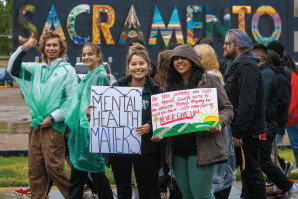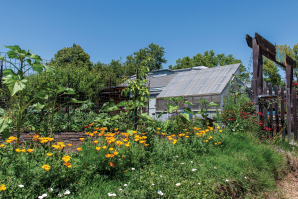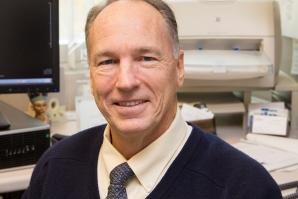When was the last time you felt awe? You may call it something else, but you know the sensation — the wide-eyed, hushed-voice, goosebumps-down-the-back feeling that comes with grand, novel experiences, the kind that become permanently seared into your memory. Perhaps you were at a mountain peak or the lip of a canyon, your eyes adjusting to the scale of what lay below you. Or you may have been underwater, looking through goggles at a vibrant world otherwise off limits to air-breathers. Perhaps you were dancing at a festival or witnessing the birth of a child.
A growing body of evidence suggests that the emotion associated with these experiences can be harnessed to improve mental health. About two decades of work on the subject has coalesced to form the “science of awe,” an interdisciplinary field driven in equal parts by philosophy, psychology and neuroscience with one of its main epicenters at UC Berkeley.
But you don’t need a group of academics to tell you that your last experience of awe — whether it was on a mountain, at a concert hall or in a hospital — had an effect on your mood. The question is whether you can access that effect in your daily life.
Consider that memory again, and now compare it to your current surroundings. If you’re like most of Comstock’s Capital Region readers, you are some distance from the nearest cliff or large body of water. Chances are you’re indoors in a setting that ceased to be novel long ago. You may think you are out of the radius of awe — at least until the weekend drives you west to the coast or east to the mountains.
Not so, according to a recent study co-authored by Javier E. López, professor of cardiovascular medicine at UC Davis. The study, the results of which were published in the journal Nature: Scientific Reports in May, found that long COVID patients could reduce their symptoms of depression by learning to find awe in their daily lives. It is one of the most rigorous studies to date on the mental health benefits of awe and its accessibility, even in quotidian settings.
“Just talking to you about it, I already have goosebumps,” López says. “It’s that powerful.”
The AWE method
Everyday experiences like the moon, water droplets on leaves and
the cricket calls can trigger awe, researchers say. (Illustration
by Melinda Arendt)

Once they were on board, participants in the intervention group joined a series of virtual classes that taught them techniques on finding awe in their daily lives. (The control group was placed on a waitlist, so they got to take the classes after the study.) A central focus of these classes, López says, was to teach that awe is accessible in all settings.
“Some people live in a city and they’re just in a building and they just look at other windows,” he says. “We didn’t want to create a sense that unless you had access to natural beauty or whatnot, you could not have this. We tried to emphasize that awe could actually be found in the ordinary. Wherever you are, in your own home, there may be things you don’t pay attention to.”
Two of the study’s co-authors, therapist Jake Eagle and pain management specialist Dr. Michael Amster, facilitated the classes. Eagle and Amster introduced participants to the AWE method that they developed, with each letter standing for a step toward harnessing the emotion. A stands for attention; W stands for “wait,” which here means a well-savored pause that lasts for a breath or two.
“Then the E stands for two things. One is a nice long exhale,” Amster says, instructing a fast-talking journalist to take a deep breath in and a longer one out. “You can probably feel yourself more grounded, centered and calm, and that’s because you’re literally tugging on your vagus nerve. It is literally like a reset for a parasympathetic response,” he says. (The parasympathetic response is part of the autonomic nervous system and is essentially the opposite of the fight or flight response — it prepares you for rest and healing instead of stress or danger.)
“E also stands for an expansion,” Amster continues. “When you have a moment of awe, you get that experience of goosebumps or chills in your extremities, and that’s because there’s this ecstatic energy that sort of expands. We’re leveraging that and allowing that to happen.”
The participants were introduced to examples of awe triggers that work for others, such as sunsets or nature videos, and were asked to follow this practice three times a day for 15 to 20 seconds at a time — but not to “try too hard,” Amster says. “What’s really unique about this practice is that it really requires you to surrender and allow the experience to sort of bubble up organically, rather than trying to make something happen.”
“We tried to emphasize that awe could actually be found in the ordinary. Wherever you are, in your own home, there may be things you don’t pay attention to.”
— Javier E. López, professor of cardiovascular medicine, UC Davis
The practice may be simple, but the results were promising. Participants in the awe group had less depressive symptoms than those in the control group. They also reported less stress and a better sense of well-being. These results suggest that awe might be a useful intervention for people dealing with chronic stress and other ailments, the co-authors say.
López and Amster don’t know what specific moments triggered awe in the trial participants — but they know what works for them, even in a place like Sacramento. “I am so grateful for the trees of Sacramento,” says Amster, who lived in Davis for 20 years and travels to the capital for work every six weeks. “I just love walking around and being in awe of the trees and the things that don’t grow where I live.”
Sacramento-based López offers another example of awe in suburbia. “If you have a little grassy area around your house, and you wake up in the early morning where there’s mist and water in the leaves, just look at the reflection of the water in the grass. It’s just beautiful. I mean, like, wow, I didn’t realize there were so many variations of green. And as you start opening your mind to the fact that there’s so many variations of green, take a few deep breaths and stay in that moment.” His speech slows as he takes his own advice. “See, I’m triggering it already.”
The philosophy of awe
Illustration by Christopher Pearse Cranch of Emerson’s
“transparent eyeball” concept. (Public domain via Wikimedia
Commons)

It is no coincidence that UC Berkeley, home of the awe-oriented Greater Good Science Center, has historically also been a hub for scholarship on transcendentalism, a school of thought that emerged in 19th-century New England emphasizing the inherent divinity of nature and humanity and the mystic connection between them. Publications on awe by the GGSC and its founding director, psychology professor Dacher Keltner, frequently quote philosophers and thinkers from the 19th century and earlier, especially transcendentalists like Ralph Waldo Emerson — also quoted in the opening letter of every issue of this magazine.
Keltner, arguably the poster boy of awe science, served as an advising co-author on the long COVID study along with Yale postdoctoral associate Maria Monroy. A 2022 research article Keltner and Monroy co-authored, “Awe as a pathway to mental and physical health,” illustrates awe with one of Emerson’s most famous — and quintessentially transcendentalist — passages, from his 1846 book-length essay “Nature”:
In the woods, we return to reason and faith. There I feel that nothing can befall me in life—no disgrace, no calamity (leaving me my eyes), which nature cannot repair. Standing on the bare ground—my head bathed by the blithe air and uplifted into infinite space—all mean egotism vanishes. I become a transparent eyeball; I am nothing; I see all; the currents of the Universal Being circulate through me; I am part or parcel of God.
The transparent eyeball later emerged as a central image of transcendentalist thought, especially its perspective on humans’ intertwined relationship with the natural world. In Keltner and Monroy’s article, it serves as an example of a depiction of awe in literature, supporting their argument that perceptive thinkers have always been aware of this phenomenon.
Keltner (who declined to comment for this article due to being “on the road for research and exploration”) often writes about finding awe in the everyday — see the subtitle of his best-selling book, “Awe: The New Science of Everyday Wonder and How It Can Transform Your Life.” Still, many of the examples of awe-inspiring moments he cites would require most people to break routine: cocooning oneself in nature like Henry David Thoreau at Walden Pond, dissolving into dance at a festival, taking psychedelics.
Most people have met someone who lives their lives in search of these kinds of transcendent experiences — or spent time living that way themselves. Eventually, like any pursuit of heightened states, this lifestyle can shape itself into something resembling an addiction, with all the accompanying detrimental effects on relationships, career and well-being.
That’s one of the reasons why the authors of the long COVID study chose to focus on everyday awe, while acknowledging that awe in the extraordinary is a valid subject of research. “When you think of those transcendentalists, they understood that there’s the grand awe out there in the extraordinary, but I think that they were all tuned into finding awe in the everyday,” says Amster.
To better define this form of awe, he paraphrases the late American Rabbi Abraham Joshua Heschel, a friend and contemporary of Martin Luther King, Jr. “Our goal should be to live life in radical amazement, to get up in the morning and look at the world in a way that takes nothing for granted,” Amster says. “Everything is phenomenal.”
Walking with awe
One way to access awe in the everyday is to take an awe walk, a style of stroll that aims to be something like Emerson’s walk into the woods in “Nature.” No woods required, however — with intention, one can become a transparent eyeball, even on a city street.
In 2020, Keltner co-authored a study with UC San Francisco neuroscientist Virginia Sturm and several other UCSF scientists on the benefits of awe walks for older adults. The researchers asked 52 healthy older people to take at least one 15-minute walk a week for eight weeks. Half of the participants were given a lesson on awe and some open-ended instructions, including “Go somewhere new, or try to recognize new features of the same old place” and “Take a moment during each walk to notice the vastness of things.”
All participants were asked to keep a journal of their thoughts during the walk and to take selfies at the beginning, middle and end of each walk. As one might anticipate, participants in the awe group reported more positive emotions, such as compassion and gratitude, and an overall sense of well-being. A less expected result is that the awe group tended to portray themselves as smaller in their end-of-walk selfies than the control group, letting the landscape fill the lens, as if recognizing their sublime insignificance in the universe.
Awe walks have become particularly popular with teachers and college professors looking to engage their students’ attention outside of the classroom. Rosalinda Salazar, a professor of English at Sacramento City College, has been hosting awe walks on the leafy campus for faculty and staff since 2023 and students since 2024, inspired by Keltner’s study and other work out of the Greater Good Science Center. A passionate runner and former running coach, she says she was drawn to the practice’s intersection between exercise and mindfulness.
“As we’re walking, I’ll point things out to them, particularly things that I’m seeing in a new light. And that really activates the walkers,” Salazar says. “They begin to point things out that they’re seeing.” One walker admired the mural on the side of the Makerspace building, featuring California poppies against a backdrop as luminously blue as the Sacramento sky above it. Another marveled at a tree that appeared to be bending in their direction.
“Not only are you out in nature, but you are opening your eyes, your mind and your body to novelty, and maybe seeing your ordinary surroundings as more than ordinary,” she says. “That sensation alone that can really transform you and your mental wellness. It’s not just euphoria — it’s a healthier look on life.”
–
Stay up to date on business in the Capital Region: Subscribe to the Comstock’s newsletter today.
Recommended For You

A Push for School-Based Mental Health
Ratcheted up by the pandemic, students’ mental health has become an important focus in schools
Schools and universities in the Capital Region have taken an array of approaches to assure mental health is one of the many pillars a student’s education addresses.

The Capital Region Is in the Vanguard of Autism Research and Treatment
Researchers, educators and students help unlock the mystery of autism
Autism is neither a disease nor a sickness. But for the increasing population of those diagnosed — one in 31 children is the current count in the U.S., according to the Centers for Disease Control and Prevention — it’s quite real. What might surprise you is that when it comes to learning about and managing autism, the Capital Region is very much in the forefront.

UC Davis Survives Potential Loss of $36M NIH Grant
Funding is for study by UC Davis Alzheimer’s Disease Research Center
A UC Davis’ Alzheimer’s Disease Research Center study, “The Clinical Significance of Incidental White Matter Lesions on MRI Amongst a Diverse Population with Cognitive Complaints,” is funded with a $35.9 million grant from the U.S. National Institutes of Health. NIH recently informed UC Davis it would terminate the grant.

Sober Curious: More People are Embracing an Alcohol-Free Lifestyle
With economic pressures, a deeper awareness of mental health issues and trends like Dry January and Sober October, Millennials and Gen Z are driving the “sober curious” movement, rethinking their relationship with alcohol to make healthier, more intentional choices.

The Power and Potential of Seaweed
From keeping oceans healthy to being used as an alternative to plastics, researchers believe seaweed has a multitude of uses
Nearly 2,000 miles northwest of Sacramento, Matthew Perkins rode a boat out into the Gulf of Alaska and saw nothing but endless potential for growth. “It’s kind of overwhelming how much opportunity there is,” he says. “You’re on the water, snow-capped mountains in the backdrop, you look down and see this incredible biomass growing. It’s literally the bounty of nature.”




